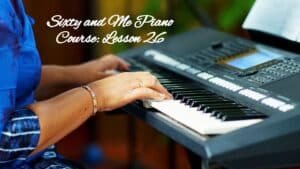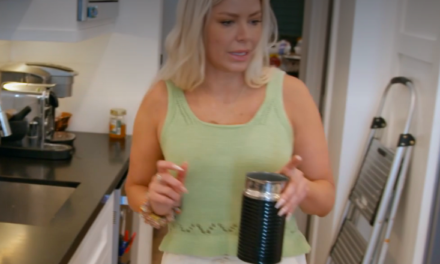
Welcome to Lesson 26!
As I started making my Lesson 26 video, I realized that it has been a year since my first Sixty and Me post on January 4, 2023! Happy Piano-versary to us! We have stuck with it, you and I, even though it has sometimes felt very difficult. I have so enjoyed the challenge of creating these piano lessons, always seeking the clearest and most concise means of communicating new musical concepts to you. I’m excited about the many lessons ahead as we continue to make our way through our piano instruction book for older adults, Upper Hands Piano, BOOK 1.
[NOTE: If you are just joining us for the first time, you can find my previous Sixty and Me Free Piano Lessons on my Author page. You can join our lessons any time and move at your own pace!]
26.1 Accidentals, p.75
Today I discuss accidentals – sharps, flats and naturals – that appear in sheet music. They are called “accidentals” because they are sharps and flats that don’t naturally occur in the key signature in which the piece is written. (We will learn about key signatures on p. 90.)
Remember that sharps raise a note by one half step up to the right, and flats lower a note by one half step down to the left. “Accidental” flats and sharps apply for the whole measure in which they appear, but do not apply in the following measure. Accidentals always appear just to the left of the printed note, on the same line or space as the notehead. A natural cancels a flat or sharp. Watch my video for more details:
26.2 Aura Lea, p.75
If you don’t know the song Aura Lea, you might think it sounds an awful lot like Elvis Presley’s hit, Love Me Tender. That’s because Elvis used the Aura Lea melody for his song. You might try writing Elvis’s lyrics in your music and singing them as you play. I also love Nora Jones’s cover of Love Me Tender. Pay special attention to the circled fingering. The circle means you will need to move your hand to play the key with the correct fingering.
26.3 Chord Calisthenics #5
Today you will start the final chord calisthenics exercise, in the Appendix p.viii in the back of BOOK 1. Try to go right to the minor triad followed by the diminished triad without playing the major triad first. I am demonstrating all 12 keys at a fast tempo, but you will slowly play just the first line for now: C to A. Notice that I am alternating hands. You can alternate hands as well, but change which hand you start with each time you play Chord Cali #5.
Passion Practice
- Exercise #1 in C, G, and D, play with hands together! – You have played all 4 of my Basic Hand Strengthening Exercises in all 12 keys! That’s a super accomplishment. Today we’re going to go back and revisit Exercise #1 on Appendix p.i, but this time you are going to play each exercise with your hands together! This will feel difficult if you have never tried it before, so take it slow. Put both of your hands in C position, and play the 5 notes of C position with each hand first, then play the exercise with hands together. Play it once FORTE (loudly), then play it again PIANO (softly) with your eyes closed! Practice Exercise #1 this way in C, G and D for the next 2 weeks.
- Play Aura Lea on p.75 observing the accidentals and the fingering. Notice that the first line is repeated.
- Chord Calisthenics #5, Appendix viii – This week you will begin Chord Calisthenics #5. Play each set of minor and diminished triads, in C, G, D and A, alternating hands, changing which hand you start with each time.
- Please review some old songs these two weeks! It would be great to review the challenging piece, Spring, by Vivaldi, on p.63. You can watch the Spring demonstration video from Lesson 20. Alternatively, review any of the pieces you like to play from BOOK 1, or any of the Sixty and Me bonus pieces posted towards the bottom of the page on my website.
Note: When you first approach a piece you haven’t played in a while, it might feel as if you have never played it before! That is intimidating! But after you play through it a few times, it will start to come back to you, and you will learn it more quickly the second time you study it.
Let’s Have a Conversation:
How does it feel to know that you have been taking lessons for a year? What have been your greatest challenges? Note reading? Fingering? Keeping your place in the music? Rhythm? Keeping a steady beat? What have been your greatest triumphs? Learning the note names? Remembering the note values? Is there a song or piece that you thought you would never learn, that you can finally play? What have been some of your favorite songs or pieces you have played in the past year? What do you love most about playing music? Tell us your piano stories, we love to hear about your progress!





